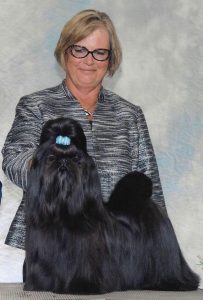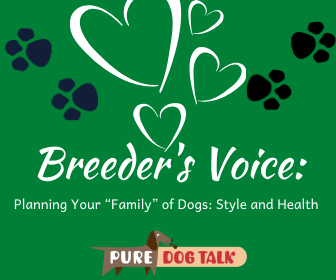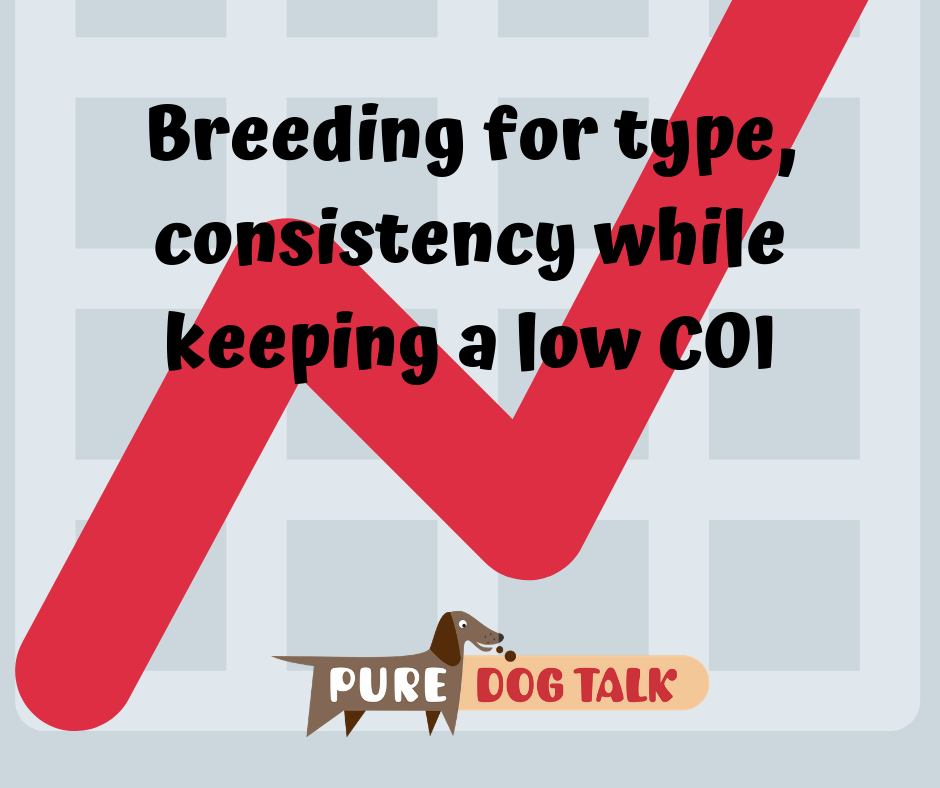397 — Planning Your “Family” of Dogs: Style and Health
Planning Your “Family” of Dogs: Style and Health
Our topic is breeding. With an emphasis on planning your family of dogs. The question: is consistency of style more important than consistency of health and/or quality? How do you get to your desired goals?
Today’s guests are Amanda Kelly, Wendy Paquette and Chris Heartz. This is part one of a two part series. Check back next week for part two!
Type to type
 Wendy: “Coming from a background of Shih Tzu, that were only recognized in United States in 1969, I didn’t have much choice when I first started my breeding program. Living in northern Ontario, the only way I could buy a female was to import two from England ’cause they were just not available. Luckily I came across Luc Boileau in Montreal who was showing English imported dogs at the time. So I was able to take my English import and breed it to one of Luc’s dogs. But that left me sort of in a quandary because I had nowhere else to go after that. So I basically started out breeding type to type.
Wendy: “Coming from a background of Shih Tzu, that were only recognized in United States in 1969, I didn’t have much choice when I first started my breeding program. Living in northern Ontario, the only way I could buy a female was to import two from England ’cause they were just not available. Luckily I came across Luc Boileau in Montreal who was showing English imported dogs at the time. So I was able to take my English import and breed it to one of Luc’s dogs. But that left me sort of in a quandary because I had nowhere else to go after that. So I basically started out breeding type to type.
“Consistency of type was a goal, but health and welfare, to me, is a major factor. If you don’t have health and welfare you don’t have quality and type either.
“I have done inbreeding, outcrossing, line-breeding. I’ve done it all throughout the years. It’s easier to do stuff like that if you have quantity of dogs. So there was a point where I had up to 50 Shih Tzu. So I could pick and choose what direction I wanted to take each line.”
Health in a small gene pool
 Amanda: “I think it depends on where your breed is. Every breed is going to be unique. How you approach setting up your own breeding program and also thinking about management of the population as a whole. So there’s a lot of things that come into play in that respect.
Amanda: “I think it depends on where your breed is. Every breed is going to be unique. How you approach setting up your own breeding program and also thinking about management of the population as a whole. So there’s a lot of things that come into play in that respect.
“As breeders, when we talk about getting consistency and cultivating aspects of breed type, we’re often talking about eliminating genetic material. In order to concentrate the genes so that we can get the head that we like or the coat that we like, we’re limiting the genes for the other things.
“(In) very small breeds, we have to not only think about what we want in our own breeding program, but also what is the best choices to make in order to cultivate the things that we think our breed needs now or may need in the future.
Cookie cutters
 Chris: “I sometimes get upset when I put a dog on the table and somebody who I maybe don’t know looks at me and says ‘Another cookie cutter.’ And it drives me crazy because I think of how many disappointments, how many hurdles we had to cross (to get our) cookie cutter right.
Chris: “I sometimes get upset when I put a dog on the table and somebody who I maybe don’t know looks at me and says ‘Another cookie cutter.’ And it drives me crazy because I think of how many disappointments, how many hurdles we had to cross (to get our) cookie cutter right.
“I was lucky enough that instead of a diamond, my husband gave me a dog as an engagement present. That dog was everything we wanted. He wasn’t perfect, but he was where we felt the breed needed to go. He had beautiful shoulders. He had reach and drive. He had a body shape that was not so common because he was actually short backed. We knew the blueprint but we made some mistakes and made some assumptions along the way.
“I have it in big bold letters: if you own a stud dog, he is not always the best breeding for your bitch. It took a long time to figure that out. I see people do it all the time. You have to know what clicks, what doesn’t click and what never to breed together.”
309 — Breeding for type, consistency while keeping a low COI
Breeding for type, consistency while keeping a low COI

Dr. Victor Stora, veterinary medical geneticist, with some of his Shetland Sheepdogs.
Victor Stora, Shetland Sheepdog breeder, AKC/CHF Residency Recipient and Veterinary Geneticist at University of Pennsylvania, shares concrete information on breeding for type and consistency of style while keeping a low COI (Coefficient of Inbreeding).
Stora observed that many breeders fall in to one of two categories.
“People might fall in to health testing too much and losing type, or you have people ignoring health because they’re getting the type they want. The happy medium is where people should be,” Stora said.
Health test all you want, Stora noted, but keep in mind it doesn’t mean the dogs are free of disease… just all the ones you can test for. What are the really bad diseases that affect a breed, he queried, adding that the more “lethal” diseases get higher priority.
Health testing and COI are tools
“Once you get to the point that you have the animals that you’ve screened, choose the ones that have the least problems health testing wise and are most like the type you desire,” Stora recommended. “Health testing is a tool, not a meter to eliminate animals because they don’t pass the bar.”
He also strongly recommends incorporating carriers of some diseases in a breeding program. “If you eliminate carriers, assuming the carrier has no disease, you’re removing dogs that are healthy. You can zoom in *too* much on health testing, and lose what you had in the beginning.”
We don’t have all the answers yet
Stora also noted that the primary diseases we want to know about, epilepsy, cancer etc, we don’t have an answer and that they are likely environmental, plus genetic.
When it comes to autoimmune disease, Stora said the breeder’s goal is to have more genetic variation to combat it.
“Outcross to a point, line breed to a point. Watch what’s happening. If you don’t choose for fertility, you’re choosing against it. Fertility is a heritable trait,” Stora said. “Nobody got into this because it’s easy. It’s not.”
Finally, Stora counseled to stop breeding affected dogs once the breed or line has started making headway against that disease.
“If the disease is rare within a breed, never breed affected because you don’t have to. If it is common within the breed, you have to use affected,” Stora said.


